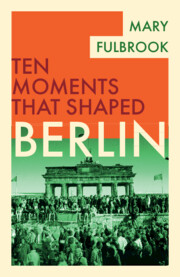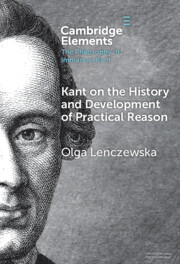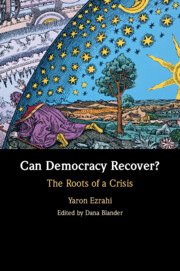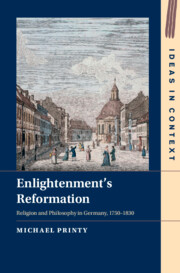Refine search
Actions for selected content:
294 results
5 - Administering the Sacraments
- from Part III - In the Interstices
-
- Book:
- Black Catholic Worlds
- Print publication:
- 11 September 2025, pp 207-247
-
- Chapter
- Export citation
Chapter 11 - Freedom of Religion and Thought in the Feyerabend Lectures on Natural Law
-
-
- Book:
- Kant's Lectures on Political Philosophy
- Published online:
- 18 July 2025
- Print publication:
- 07 August 2025, pp 199-218
-
- Chapter
- Export citation
Chapter 12 - Happiness, Paternalism, and Social Welfare
-
-
- Book:
- Kant's Lectures on Political Philosophy
- Published online:
- 18 July 2025
- Print publication:
- 07 August 2025, pp 219-237
-
- Chapter
- Export citation
5 - Darkness in Light
-
- Book:
- Silence of the Gods
- Published online:
- 19 June 2025
- Print publication:
- 19 June 2025, pp 281-330
-
- Chapter
- Export citation
Chapter 2 - On Power in an Extra-secular Sense
- from Part I - Kant on Literature
-
-
- Book:
- Kant and Literary Studies
- Published online:
- 16 May 2025
- Print publication:
- 05 June 2025, pp 43-70
-
- Chapter
- Export citation
Chapter 10 - European Literature, Dante to Rousseau
- from Part II - Intellectual, Cultural, and Political Contexts
-
-
- Book:
- Percy Shelley in Context
- Published online:
- 17 April 2025
- Print publication:
- 24 April 2025, pp 74-81
-
- Chapter
- Export citation
15 - Popes, the Body, Medicine, and the Cult of Saints after Trent
- from Part III - Science, Medicine, Technology
-
-
- Book:
- The Cambridge History of the Papacy
- Published online:
- 28 February 2025
- Print publication:
- 20 March 2025, pp 422-454
-
- Chapter
- Export citation
30 - The Papacy and the Jews since the French Revolution
- from Part V - Inter-Faith Relations: Confrontation and Dialogue
-
-
- Book:
- The Cambridge History of the Papacy
- Published online:
- 28 February 2025
- Print publication:
- 20 March 2025, pp 770-792
-
- Chapter
- Export citation
Kant’s Legal Positivism and Natural Law Theory
-
- Journal:
- Kantian Review , First View
- Published online by Cambridge University Press:
- 20 March 2025, pp. 1-22
-
- Article
- Export citation
16 - Enlightenment and Its Aftermath: Liberalism, Socialism, and Nationalism
- from Part III - Reformations and Revolutions
-
-
- Book:
- The Cambridge History of the Papacy
- Published online:
- 28 February 2025
- Print publication:
- 20 March 2025, pp 427-456
-
- Chapter
- Export citation
Chapter 16 - Political Poetics: Intercrossing Discourses and American Belonging
- from Part III - Genres
-
-
- Book:
- The Cambridge Companion to Nineteenth-Century American Literature and Politics
- Published online:
- 06 March 2025
- Print publication:
- 13 March 2025, pp 271-288
-
- Chapter
- Export citation

Berlin
-
- Published online:
- 13 February 2025
- Print publication:
- 30 January 2025
The Horn of Enlightenment: Mozart's Operatic Use of the Clarinet
-
- Journal:
- Cambridge Opera Journal / Volume 36 / Issue 3 / November 2024
- Published online by Cambridge University Press:
- 11 February 2025, pp. 267-294
-
- Article
-
- You have access
- Open access
- HTML
- Export citation
2 - An Enlightened Civil Society?
- from I - 1750–1819: The Ends of the Ancien Régime
-
- Book:
- Modern Britain, 1750 to the Present
- Published online:
- 14 January 2025
- Print publication:
- 30 January 2025, pp 40-74
-
- Chapter
- Export citation

Kant on the History and Development of Practical Reason
-
- Published online:
- 16 January 2025
- Print publication:
- 30 January 2025
-
- Element
- Export citation
14 - The Loss of Self-Evident Public Facts and the Crisis of the Commonsense Conceptions of Reality
- from Part IV - The Erosion of the Epistemological Constitution of Modern Democracy
-
- Book:
- Can Democracy Recover?
- Published online:
- 02 January 2025
- Print publication:
- 16 January 2025, pp 139-149
-
- Chapter
- Export citation
Chapter 7 - Religion, Anticlericalism and the Worldly Paths to Happiness in Hume’s Essays
- from Part II - Philosophy
-
-
- Book:
- Hume's <i>Essays</i>
- Published online:
- 02 January 2025
- Print publication:
- 09 January 2025, pp 125-140
-
- Chapter
- Export citation
Chapter 2 - The Reception of Hume’s Essays in Eighteenth-Century Germany
- from Part I - Reception
-
-
- Book:
- Hume's <i>Essays</i>
- Published online:
- 02 January 2025
- Print publication:
- 09 January 2025, pp 36-51
-
- Chapter
- Export citation

Can Democracy Recover?
- The Roots of a Crisis
-
- Published online:
- 02 January 2025
- Print publication:
- 16 January 2025

Enlightenment's Reformation
- Religion and Philosophy in Germany, 1750–1830
-
- Published online:
- 21 December 2024
- Print publication:
- 05 December 2024
